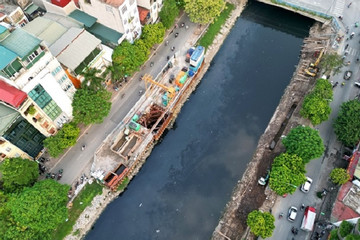- © Copyright of Vietnamnet Global.
- Tel: 024 3772 7988 Fax: (024) 37722734
- Email: [email protected]
water pollution in vietnam
Update news water pollution in vietnam
Hanoi accelerates To Lich River restoration with support from three ministries
With a budget of USD 22 million, Hanoi is set to complete a large-scale water replenishment project by September 2025 to revive the polluted To Lich River.
Hanoi sets 2025 deadline for To Lich River revival
Following General Secretary To Lam’s directive, Hanoi authorities are expediting the clean-up and revitalization of the To Lich River, supported by new wastewater treatment infrastructure.
After eight years, when will Hanoi’s To Lich River see clean water?
Despite an $800 million investment in the Yen Xa Wastewater Treatment Project, Hanoi’s To Lich River continues to suffer from untreated sewage and persistent delays.
To Lich River pollution: Black water returns despite initial improvement
On July 1, as West Lake discharged its flow into the To Lich River, the water color suddenly turned green, and the stench in the area significantly reduced. However, on the morning of July 2, the pitch-black color reappeared.
Hanoi should promote its rivers and lakes more
The city’s unique natural features with a dense network of rivers and lakes creates the distinctive geographical and beautiful, characteristics of the capital city.
HCM City to remove 6,000 slums, revive 'black' canals
To revive polluted canals, HCM City will have to clear 6,000 slums. It is estimated that the city will have to spend VND20 trillion for site clearance.
Hanoi’s wastewater project to undergo trial operation
Once the project is officially operational, waste water from 150 main sewers along the banks of the To Lich River will be collected and treated before being discharged into the river.
HCM City strongly handling canal pollution
HCMC has been trying to eliminate water pollution in its canals in order to improve the living environment for local inhabitants there.
Radical, sustainable solutions needed for HCM City’s polluted canals
Despite having gone under a renovation project, the signs of pollution in these streams are becoming more evident than ever.
HCMC to spend VND8.5 billion collecting garbage on Saigon River
The HCMC People’s Committee has approved a plan for renting garbage collecting machines to clean up the Saigon River over the next six months, with a budget of over VND8.5 billion.
Over 1 mln cu.m of industrial wastewater dumped everyday in Vietnam
Industrial parks nationwide discharge more than a million cubic metres of wastewater each day, 75 percent of which is untreated and harmful, according to a workshop held in Hanoi on December 1.
Dong Nai River terribly polluted
VietNamNet Bridge – The entire basin of Dong Nai river system has to receive waste water discharged from over 4,500 sources, including factories, mining enterprises, craft villages, and residential areas.











